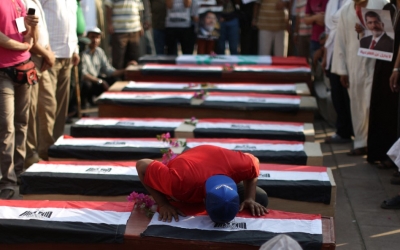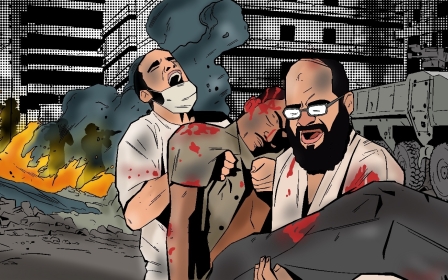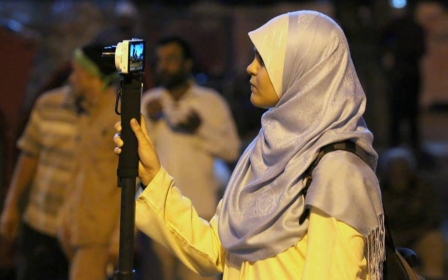Rabaa massacre: The founding social contract of Sisi's new republic

Ten years ago in broad daylight, Egypt’s police and military carried out the biggest massacre in the country’s modern history.
Bulldozers were sent in to demolish a protest camp set up at Rabaa al-Adawiya Square by supporters of Mohamed Morsi, the country’s first democratically elected president, who was deposed in a 2013 coup.
Phalanxes of armed, black-clad security forces opened fire on protesters, killing at least 817 people in a single day. Other estimates of the casualties run into the thousands.
The massacre came on the heels of continuous incitement by the state-run and privately owned Egyptian media, whose journalists and commentators had screamed for weeks about how the anti-coup protest camp had devolved into some sort of “terror” hub. Worse, the leftist opposition issued a joint statement a week before the massacre, lambasting the state for not moving swiftly enough to suspend the “fascist terrorist” protest camps.
On the 10th anniversary of these bloody events, the question is not what happened, as this has already been well documented. What remains puzzling for many is why it happened. Why did General Abdel Fattah el-Sisi feel obliged to unleash this killing spree, which was broadcast live to every Egyptian home?
New MEE newsletter: Jerusalem Dispatch
Sign up to get the latest insights and analysis on Israel-Palestine, alongside Turkey Unpacked and other MEE newsletters
Former President Hosni Mubarak was an autocrat who ruled Egypt with an iron fist, but his approach to governance depended on managing dissent. A vibrant civil society existed as a buffer between the state and its citizens. Policing dissent was outsourced to a wide array of civilian institutions, not just the security services.
True, these institutions were already partially dismantled, and not as powerful as those created by the founder of the officers’ republic, Gamal Abdel Nasser, but they were still effective in shielding the state from existential threats.
Enforcing state hegemony
If atrocities took place in Palestine, Mubarak could count on the Muslim Brothers to defuse popular anger in Egypt by organising anti-Israel protests that would be confined to mosques and university campuses, rather than spilling out into the streets or chanting against Mubarak and his complicity.
If prices of basic commodities soared, Mubarak could count on the Salafis to divert anger from the regime by blaming unveiled women or Christians. If industrial actions broke out, he could count on the state-backed trade unions to counteract militancy in workplaces.
The country had become ungovernable, and the generals decided to pacify it by force once and for all
Moreover, there was the ruling National Democratic Party, which was unideological and toothless compared with Nasser’s Arab Socialist Union - yet it had a presence in every neighbourhood in Egypt to enforce the state’s hegemony, resolve potential conflicts, and channel local grievances to the regime’s decision-makers.
In other words, there was a complex web of institutions upon which Mubarak could depend to manage dissent, before he considered sending in the troops or his feared state security police to crack down on the troublemakers.
State violence under Mubarak was mostly calculated, corresponding to the perceived level of threat to the regime. His propaganda machine went far in trying to hide any abuses, from denial to disinformation.
This perverse calculus of repression enabled Mubarak’s regime to thrive for three decades. But in the eyes of Sisi and his generals, this was exactly what eventually led to Mubarak’s demise and the outbreak of the 2011 revolution.
Sending a message
Sisi and most of his officers who led the 2013 coup graduated from military college after the end of the 1973 war, ascending the ranks in times of “peace”. The Egyptian army by then had become a bloated bureaucratic organisation, obsessed with domestic stability and profiteering. It was neither humbled by military defeats, nor experienced the blunders of military rule under Nasser.
In the army’s eyes, the revolution happened because Mubarak was “too lenient”. The experience of the 2011-13 transition only helped to cement this conviction. The generals’ Faustian bargain with the Islamists - to defuse the revolution in exchange for the latter becoming part of the ruling coalition - was going nowhere.
In 2012 alone, the Egyptian Center for Economic and Social Rights recorded more than 3,800 industrial actions and social mobilisations in the country - more than the total number of protests in the decade spanning 2000-10.
The country had become ungovernable, and the generals decided to pacify it by force once and for all to save the state from “chaos” - or, even worse, a new revolution that could threaten their privilege. The death toll of one day, 14 August 2013, was almost equal to the total number of deaths during the 1990s crackdown under Mubarak. During the initial seven months after Sisi’s coup, state violence left more than 3,200 dead.
The sheer scale of the Rabaa bloodshed and post-coup massacres was a clear message by the generals to the nation: that independent collective action was neither welcome nor permissible. While the country witnessed more than 4,500 protests in the first six months of 2013, that number plummeted to 665 during the last six months of the year.
Today, Sisi presides over a society with no buffers: crippled opposition parties, a rubber-stamp parliament, no official ruling party, and no civilian institutions whatsoever with governing powers. Instead, the repressive apparatuses (military, police and general intelligence service) impose direct rule, micromanaging society on a daily basis.
Sisi does not manage dissent; he eradicates it. Rabaa was not just a massacre. It was the founding social contract of Sisi’s new republic.
The views expressed in this article belong to the author and do not necessarily reflect the editorial policy of Middle East Eye.
This article is available in French on Middle East Eye French edition.
Middle East Eye delivers independent and unrivalled coverage and analysis of the Middle East, North Africa and beyond. To learn more about republishing this content and the associated fees, please fill out this form. More about MEE can be found here.






